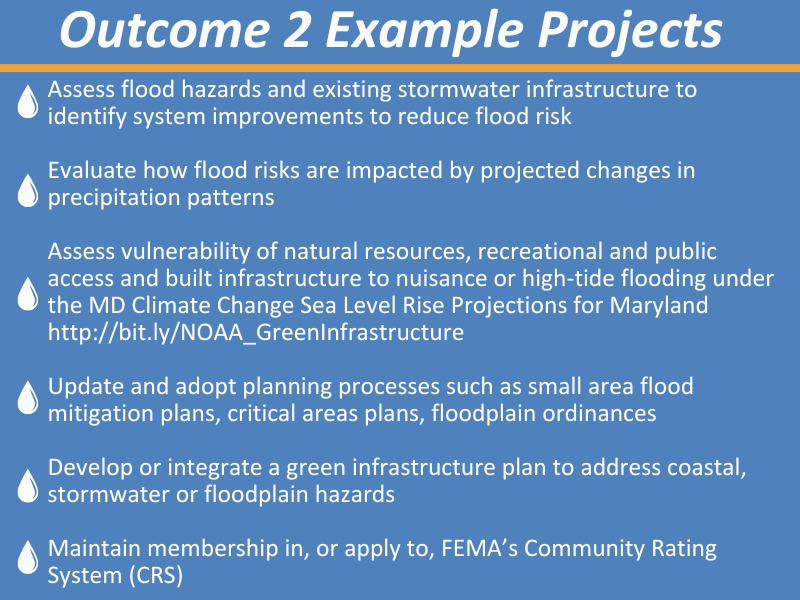Apply to Outcome 2 to understand and enhance capacity to plan for impacts from coastal and precipitation based flood events.
Important Notice for Outcome 2 Applicants:
Outcome 2 is currently open for applications, although this funding opportunity is supported through federal funding and availability of funds may change at a later date. Applicants interested in this outcome are encouraged to monitor the Grants Gateway and DNR’s website for updates as well as the DNR newsletter. If you have a WizeHive account you will receive an email notification if the outcome changes at a later date. Proposals may be selected for financial assistance through a grant award, or technical assistance through a DNR contractor. At this time, projects may only be located within Maryland’s Coastal Zone.
Watershed & Climate Services supports communities to address adaptation in three phases: Understand, Plan, and Implement. Each phase reflects a step towards a resilient community that addresses the challenges of today and tomorrow.
Flooding impacts to be addressed may be at the community, county, or municipal level and may be the result of high tide flooding, changing sea levels, and/or an increased incidence and severity of precipitation events. The final products produced through this funding should serve as the foundation for implementable projects.

Projects that address tidal flooding should reference the jurisdiction’s nuisance flood plan, flood mitigation plan, or other planning processes to show how it aligns with ongoing risk reduction strategies. Applicants are strongly encouraged to use the
Guidance for Using Maryland’s 2018 Sea Level Rise Projections to determine flood risk tolerance and sea level rise estimates for long term projects. Projects addressing precipitation-induced flooding should be consistent with the trends described in the
Northeast chapter of the Fourth National Climate Assessment and illustrated for the project’s target area through the
Projected Intensity-Duration Frequency (IDF) Curve Data Tool for the Chesapeake Bay Watershed and Virginia.
Applicants are encouraged to submit photos of flood impacts which can be done through
MyCoast: Maryland. This tool is a portal to collect and analyze photos of flooding that are linked to precipitation, riverine, and tidal data and can help applicants demonstrate the current-day flooding in their project location.
Solicitation Details
Maximum request: $125,000
When is this proposal due?
December 12, 2025
When is funding available?
October 1, 2026
How much funding is available?
Proposal requests typically range from $40,000 - $100,000 for projects that will be a maximum of one year in duration. If awarded, applicants should be open to either receiving direct financial support or technical assistance through a Watershed & Climate Services selected provider.
Who is eligible to apply?
Local jurisdictions, non-governmental organizations, institutions of higher education.
Where can my project(s) be located?
Projects can be located within Maryland’s Coastal Zone (see map for details). Since these are planning projects, the project area can encompass both public and private lands.
What kind of projects are supported by Outcome 2?
Projects that seek to improve a local government’s understanding of flood impacts and vulnerabilities and that address those impacts at a community scale are encouraged to submit a proposal. Flood impacts may be at the community, county, or municipal level and may be the result of high tide flooding, changing sea levels, and/or an increased incidence and severity of precipitation events. Proposed projects can plan for either or both short (1-10 years) and long (+10 years) term flood impacts.
Proposed projects can support risk assessments to understand current and future vulnerability, identify and incorporate adaptation strategies into current planning processes, and develop conceptual designs or engineered for identified adaptations. Project outcomes and deliverables should result in risk-reduction strategies and/or higher regulatory standards that propel the implementation of identified on-the-ground adaptation projects.
How is my proposal reviewed and selected for an award?
- Proposal Completeness: All sections of the proposal were satisfactorily completed.
- Problem and Need: The proposal describes a significant local need to address a problem resulting from climate-induced flood impacts.
- Appropriateness of Proposed Work: The proposed project presents a technically- and financially-feasible approach to address the defined problem and identify short-term and long-term solutions.
- Use of Climate Resources and Tools to Assess Impacts: Proposals addressing sea level rise provide a completed Appendix A from the Guidance for Using Maryland’s 2023 Sea Level Rise Projections. Proposals describe which climate tools and resources were used to develop the proposed approach.
- Advances Flood Risk Reduction or Adaptation Strategies: The proposed work fits into the larger context of community efforts to reduce flood risk and climate impacts.
- Community and Stakeholder Engagement: the proposal describes how the project will engage the local community and/or appropriate stakeholders, including the government body that has to adopt or approve the final deliverables. The proposal describes how the applicant intends to address environmental justice and the needs of historically underserved, overburdened, and BIPOC communities.
- Partners: Partners are identified and have demonstrated a commitment to participate.
- Program Change and Readiness to Proceed: Proposals commit to achieving a program change, which could be a change in local programs, policies or decisions that reduce vulnerability to flood impacts. The proposal demonstrates clear intent to advance any recommended/identified solutions.
What are the Required Attachments?
- A Transmittal Letter on official letterhead that is signed by an executive who is authorized to request funding on behalf of the applicant organization.
- Letters of support from county or town council, town administrator, county executive, or appropriate decision-making body.
- Photographs of impacted areas.
- Complete Budget Table. Available on the main Grants Gateway website.
- Complete Appendix A: Guidance for using Maryland’s 2023 SLR Projections (applicable to projects addressing sea level rise). Available on the Grants Gateway website.
- Communication and Engagement Strategy.
Contact:
Nicole Carlozo
[email protected]
410.260.8726
